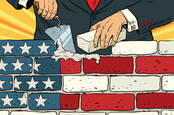Political Poker? Tariff Hunger Games? Trump Creates Havoc For PC Industry
Comment US President Donald Trump's "volatile trade policies" are creating uncertainty among suppliers of computers and among biz customers looking to use budgets wisely amid a game of on-and-off Oval Office tariffs.
The taxes levied by the US administration on China and Mexico are going to hit Americans in the pocket, with some estimates that the cost of PCs are set up shoot up by as high as 68 percent.
The majority of these devices sold stateside are produced in mainland China, which was hit by an extra 10 percent Trump tariff on Monday, March 3. HP, Lenovo, Dell and others also manufacture PCs in Mexico, a country hit with a 25 percent import duty from Team Trump on the same day, only for it to be delayed by a month on Tuesday, March 4. Canada is facing the same threat.
"President Trump's ongoing trade war with Canada, Mexico, and China has had swift negative repercussions for the stock market and pushed the US GDP growth forecast for Q1 2025 into negative territory," said Canalys analyst Greg Davis.
"In addition to the direct impact of tariffs, the stop-start nature of announcements and delays have cast uncertainty around pricing for consumer electronics this year. The tariffs have prompted mitigating actions across the PC industry, with vendors and channel partners engaging in some recent stockpiling of devices."
A survey of US computer distributors and resellers by Canalys indicates that 50 percent had upped PC inventory to five weeks or more in January versus 29 percent in November, when the new US president was elected.
The channel - the term for companies operating in the supply chain - typically prefers to hold less kit in warehouses, because devices age and cost money to discount if they don't sell. Likewise, it's clear - if Canalys is correct - that suppliers spotted a prospective commercial benefit in hiking stocks when talk of tariffs began in November.
Gartner forecast 2025 to be a "very dynamic market" as tariffs - described by Trump as "the most beautiful word in the dictionary" - whip IT buyers into a "frantic state of concern." Distinguished VP John David Lovelock told us previously he expects uncertainty to linger throughout the year.
- HPE revenue outlook feels the thump of Trump tariffs
- TSMC promises $100B US expansion that Trump hails without clarifying chip tariff threat
- Microsoft unveils finalized EU Data Boundary as European doubt over US grows
- Profit slide at HP can only mean one thing: Hammer time
"At a certain point, it won't matter because budgets are budgets, and budgets have been set, and CIOs will spend their budget. What becomes the open question is how much value will they get? Because if I have to pay 25 percent more for my PCs, I'm still going to spend my PC budget, I'm just going to have fewer new PCs.
"So, in one sense, it doesn't matter if the forecast is the forecast because it's based on budgets, expectations and market mechanics. On the other hand, it matters very much to who's going to be able to make that money and how much value CIOs will be able to extract for their dollars," he said.
Canalys estimates that PC shipments in the US totalled 17.7 million in calendar Q4, up 6 percent year-on-year. It projects that unit sales into the channel will fall just shy of 2 percent growth in 2025 and 2026, "hovering between 70 to 72 million units each year."
Reg readers obviously don't care how big the PC market grows or shrinks by, unless they work at the PC vendors or channel suppliers. All do care if they get stung in the wallet by Trump tariffs, however. Inflation in the PC industry is unlikely to lead to a surge of demand, especially for AI PCs, which already cost significantly more than the average priced bog-standard non-AI notebook.
Still, PC makers can surely cling to the boon that is Windows 11 migration? That's not a certainty, according to Davis at Canalys. He described this refresh cycle as "fertile ground for Apple to target both consumers and businesses that may be open to switching operating systems."
Davis points to Apple growing Mac sales by almost 26 percent during Q4 in the US to 3 million units. This can be compared with a 3.6 percent decline by market leader HP (4.495 million units), and 2.4 percent shrinkage by Dell (3.679 million units).
"Historically, manageability and compatibility issues were highlighted as reasons for larger commercial customers to eschew Apple products. However, many of those issues have been addressed by Apple, and along with more competitive pricing… 2025 is set to see Mac make market share gains within the commercial segment."
Apple Macs are primarily built in China, though some models are assembled in Taiwan and on home soil. Apple pledged last month to spend $500 billion over the next four years on upping R&D, AI development, and chip manufacturing in the US, yet it did not commit to making more Macs in the country itself, so that tech will not be immune to Trump tariffs anytime soon.
As for the man in the White House who is parking his economic tanks on the lawns of neighbours and arch enemy China, Trump says he is trying to bring manufacturing home to the US and seems to be gambling that short-term pain will be a long-term gain.
Or maybe - as seems likely - he isn't even thinking that far into the future and is simply using tariffs as a mechanism to negotiate with friends and enemies, with the American public caught somewhere in the middle of this game of political poker.
It is also possible Trump - the Hokey Pokey Potus - will reverse-ferret and cut the tariffs. They might not seem so beautiful if the economy tanks, the cost of living soars, and MAGA becomes Make America Grab All-it-can. ®
From Chip War To Cloud War: The Next Frontier In Global Tech Competition
The global chip war, characterized by intense competition among nations and corporations for supremacy in semiconductor ... Read more
The High Stakes Of Tech Regulation: Security Risks And Market Dynamics
The influence of tech giants in the global economy continues to grow, raising crucial questions about how to balance sec... Read more
The Tyranny Of Instagram Interiors: Why It's Time To Break Free From Algorithm-Driven Aesthetics
Instagram has become a dominant force in shaping interior design trends, offering a seemingly endless stream of inspirat... Read more
The Data Crunch In AI: Strategies For Sustainability
Exploring solutions to the imminent exhaustion of internet data for AI training.As the artificial intelligence (AI) indu... Read more
Google Abandons Four-Year Effort To Remove Cookies From Chrome Browser
After four years of dedicated effort, Google has decided to abandon its plan to remove third-party cookies from its Chro... Read more
LinkedIn Embraces AI And Gamification To Drive User Engagement And Revenue
In an effort to tackle slowing revenue growth and enhance user engagement, LinkedIn is turning to artificial intelligenc... Read more




